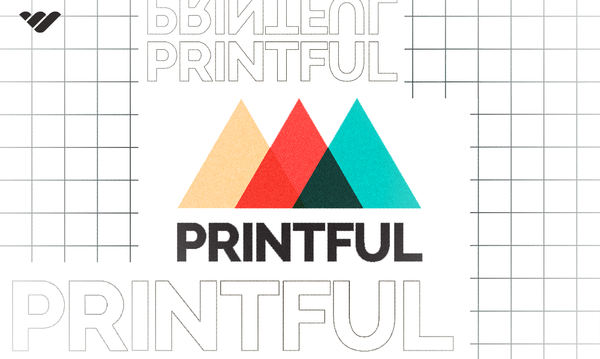With over 1 million users, Printful is one of the most popular and trusted POD services around. But it faces fierce competition from the far more popular Printify.
Given the importance of quality printing and reliable shipping, we’ve taken a deep dive and reviewed Printful in all its key areas.
Short on time? Here's the summary of our findings on Printful.
| Pros | Cons |
|---|---|
| Free to use | No team management |
| Vast integration options | Limited production selection (200) |
| Reputable brands | No phone support |
| Custom packaging | Higher product costs than rivals |
| Built-in designer | |
| Global shipping |
What is Printful?
Printful is a print-on-demand (POD) service founded in California in 2013. With a free-to-use approach, you can use it to print designs on products that are made, printed, and shipped by Printful.
Like some other POD solutions, it features a built-in designer, product catalog, and integration options to use the platform on external sites and marketplaces.
Printful currently has over 1 million users and has printed onto over 10 million products, making it one of the most popular POD options. It is closely rivaled by Printify and RedBubble. In this Printful review, we’ll analyze it in detail to help you make an informed decision about which platform is best for you.
How Printful works
To use Printful, you’ll manage a store, create designs, and market your products to make sales. The rest is taken care of by Printful - including printing, product manufacturing, packaging, and shipping.
With no upfront costs, you’ll instead cover the cost of each product after a sale is made (which is taken from your revenue).
To use Printful, you just need to sign up, connect your store, create products, and set up billing. We’ll review the process step by step below.
Printful pricing
Free to use
Printful is entirely free to use and start selling with, for up to 10 stores.
There are no paywalls to core and essential features. You only pay the cost of the product after an order is placed. You will also need to pay for shipping unless you request that the customer does.
You’ll also benefit from free integrations, custom packaging slips, a resource hub, and live chat.
For example, if you sell a Printful printed mug for $10 and it costs $5 to produce, then you’ll give $5 back to Printful and profit the remaining $5.
Premium Printful
You can upgrade your account to gain some additional features with Printful Growth. This monthly-paid membership comes with fixed discounts and various other paid-option unlocks, including additional branding, custom delivery options, custom packaging, and photo or video shoots.
If you have a large business, you can also take advantage of ‘Printful Enterprise’. The enterprise service can fulfill orders for non-Printful products too and is trusted by the likes of Coca-Cola, Viacom, NBC, MTV, and Comedy Central.
How much can I make per sale with Printful?
Your profit margins will vary depending on the retail pricing you set and the price of the products on the Printful catalog. There are no fees taken out of each sale. Printful recommends a 30% markup to make consistent growth.
For example, imagine you sell a $10.25 unisex t-shirt for $20. After US shipping of $4.49, you’ll profit $5.26. You can choose for your customers to pay for the shipping if you’d like to increase your profit margins.
These estimations do not factor in taxes. Larger volumes of orders can also qualify for perks, such as 55% off for units of 25+ select products.
Printful review: What does Printful do well?
Wide choice of brands
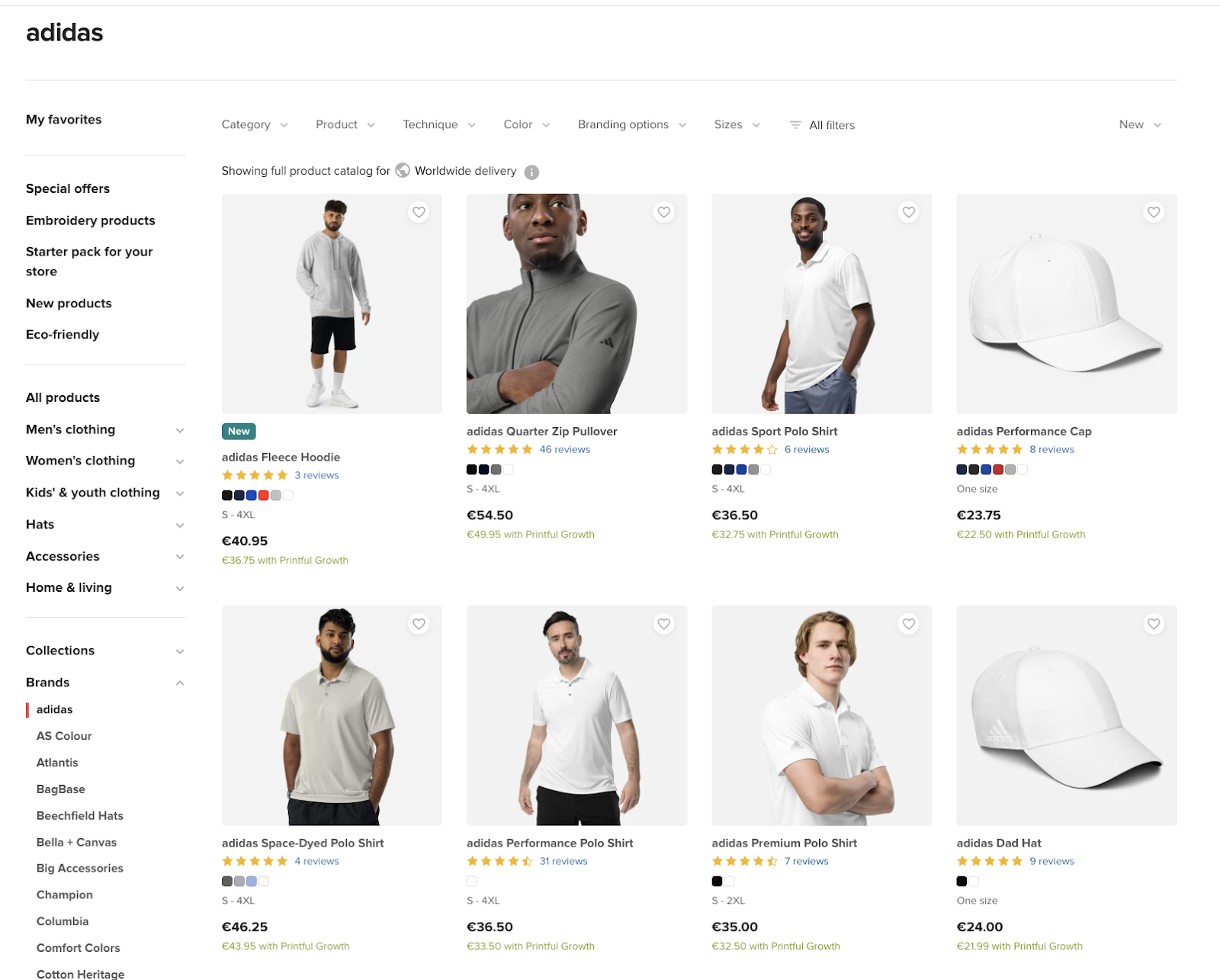
Printful features around 30 different clothing brands, including household names like Adidas, Columbia, Champion, and Under Armor.
This is a big plus compared to many POD services that offer unbranded apparel and gives you the chance to appeal to customers who want known labels and reputable manufacturers. It also gives them the incentive to pay the higher prices that you set.
Custom packaging
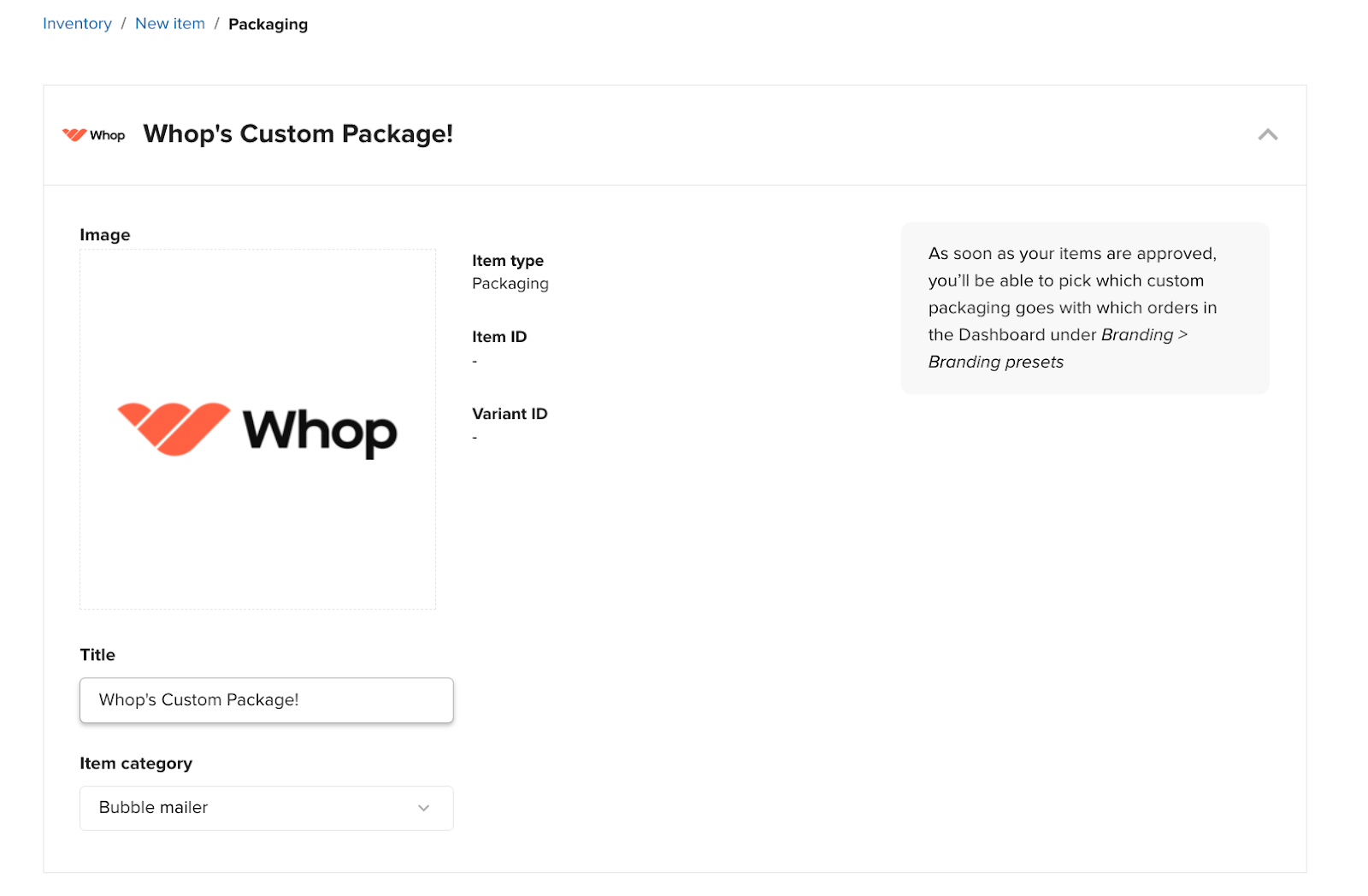
Few POD services offer custom packaging, but Printufl does! You can select the ideal materials and packaging look so that your customers have an impressive experience as soon as they receive their item. You can use brand colors, customize the label, leave social media tags, and slip in a custom message.
Design
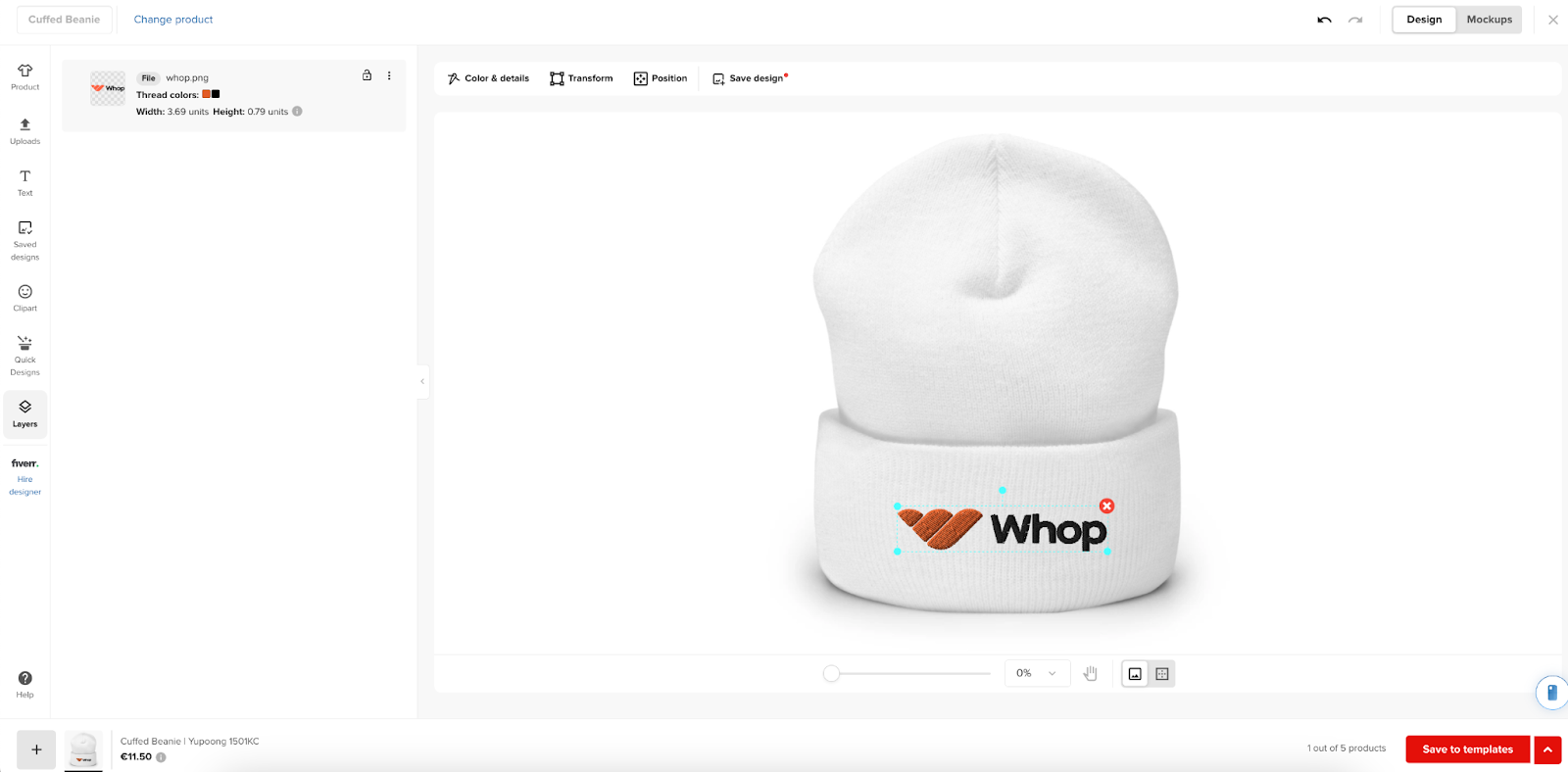
Designing on Printful is very easy. The designer works intuitively, with the ability to change colors, and materials and upload custom images in seconds. You can also use premade graphics, clipart, and text and hire a designer with a built-in Fiverr connection. We have no criticisms of Printful’s design functions.
Shipping
Printful uses leading shipping services to ensure delivery is fast and secure, including FedEx, UPs, DPD, DHL, Royal Mail, and Australia Post. You can even track real-time shipping rates, returns, and order status.
By default, shipping is set to paid by the merchant but you can change this to the customer if you prefer.
As a result, its shipping costs are slightly higher than competitors, but it is considered faster than Printify which uses other companies to handle their shipping.
An order to the U.S. will take 2-6 days, but you should also factor in the product printing time (which is indicated on the product page).
User interface
The user interface is slick throughout. We carefully thought about whether it would be overwhelming to a newbie and believe there is only a small learning curve to understand the extent of what Printful offers.
The actual navigation is easy, thanks to the dashboard and organized panels and tabs. There is also a handy search bar at the top of the dashboard to find specific features or settings without clicking about.
Integrations
Integration is where Printful shines. There are 23 integration opportunities, so you can feature your products on external ecommerce platforms, marketplaces, and websites.
This is far more than most POD services, including Printify. You can also make use of API to insert it into your website, app, or other platform.
Printful integrations include Shopify, Etsy, WooCommerce, and many others.
Where does Printful fall short?
Team management
Printful does not offer any form of role-making or team management, which is a setback for any business that wants to share duties with its employees. The only workaround is to share a password, which poses security risks and logistical hurdles.
We’d prefer it if you could assign, for example, a designer who is unable to access billing but can edit product designs.
Product selection
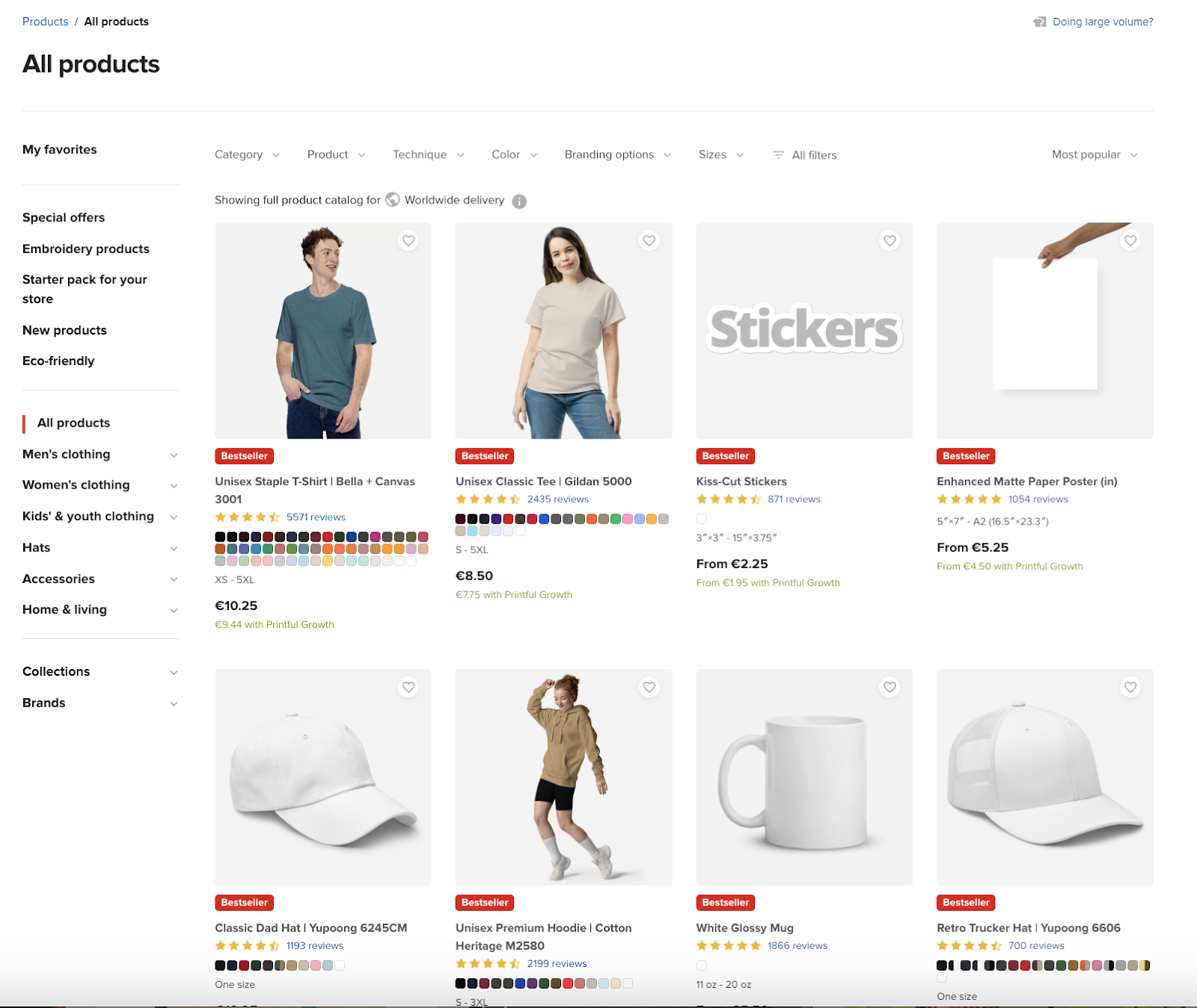
Printful features 200 products, which isn’t bad, but is significantly lower than the 900 offered by Printify. When browsing the product catalog, we found there are all the core essentials such as apparel, mugs, and bottles, but there isn’t the same level of customization as Printify.
That means you can only offer basic items and not items that might feel special, seasonal, or tailored toward your specific audience.
Profit margins
Due to the cost of products in Printful’s store, profit margins are naturally higher than its number one competitor, Printify. Also, by default, the shipping must be covered by the merchant. However, you can change this in your settings.
Mock-ups
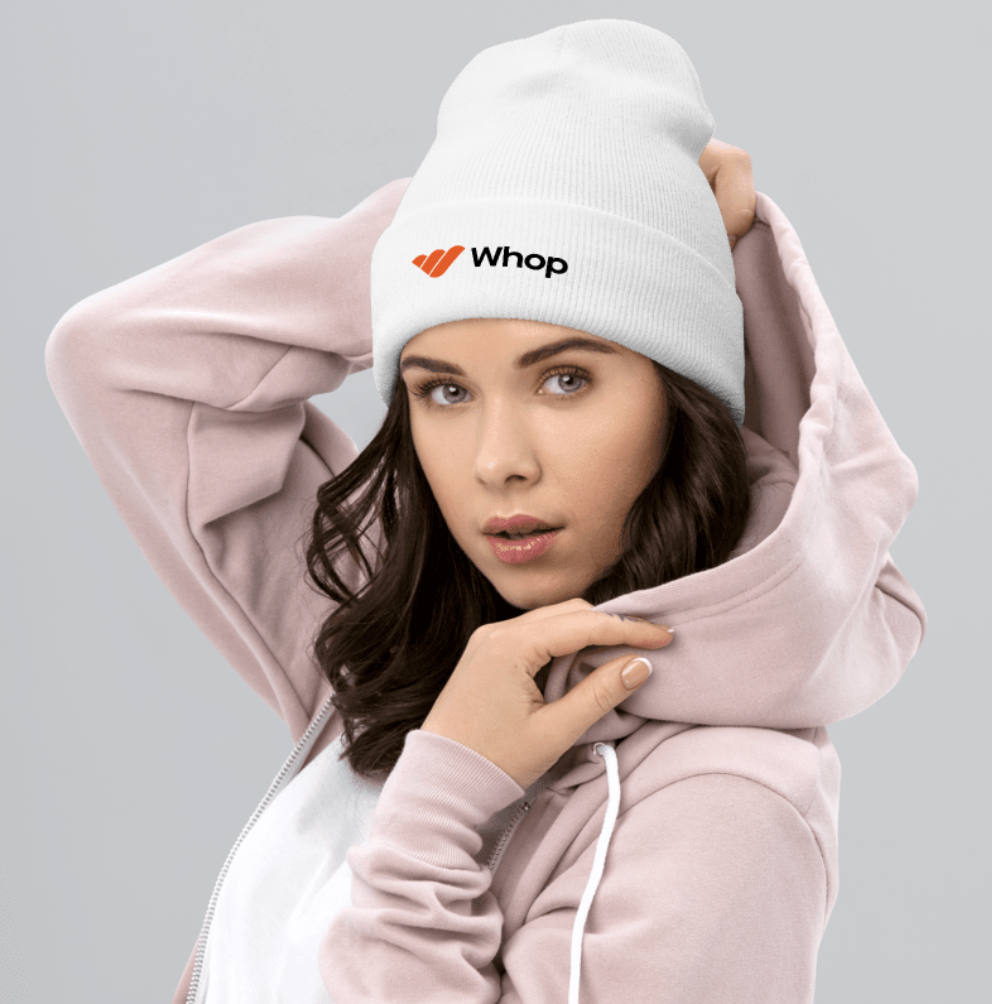
Printful mock-ups are hit-and-miss. While they are appropriate for previewing what your designs will look like on a product, they look unconvincing if you want to use them as product pictures or share them on social media.
The backdrops are often poor and cheap and the overlay of designs also doesn’t look as natural as they do on Printify. In its defense, if you do like the look of
Printful’s mock-ups then you’ll be extremely happy with their large selection of custom mock-up options.
Using Printful: A complete walkthrough of signup, features, and design
Creating your account
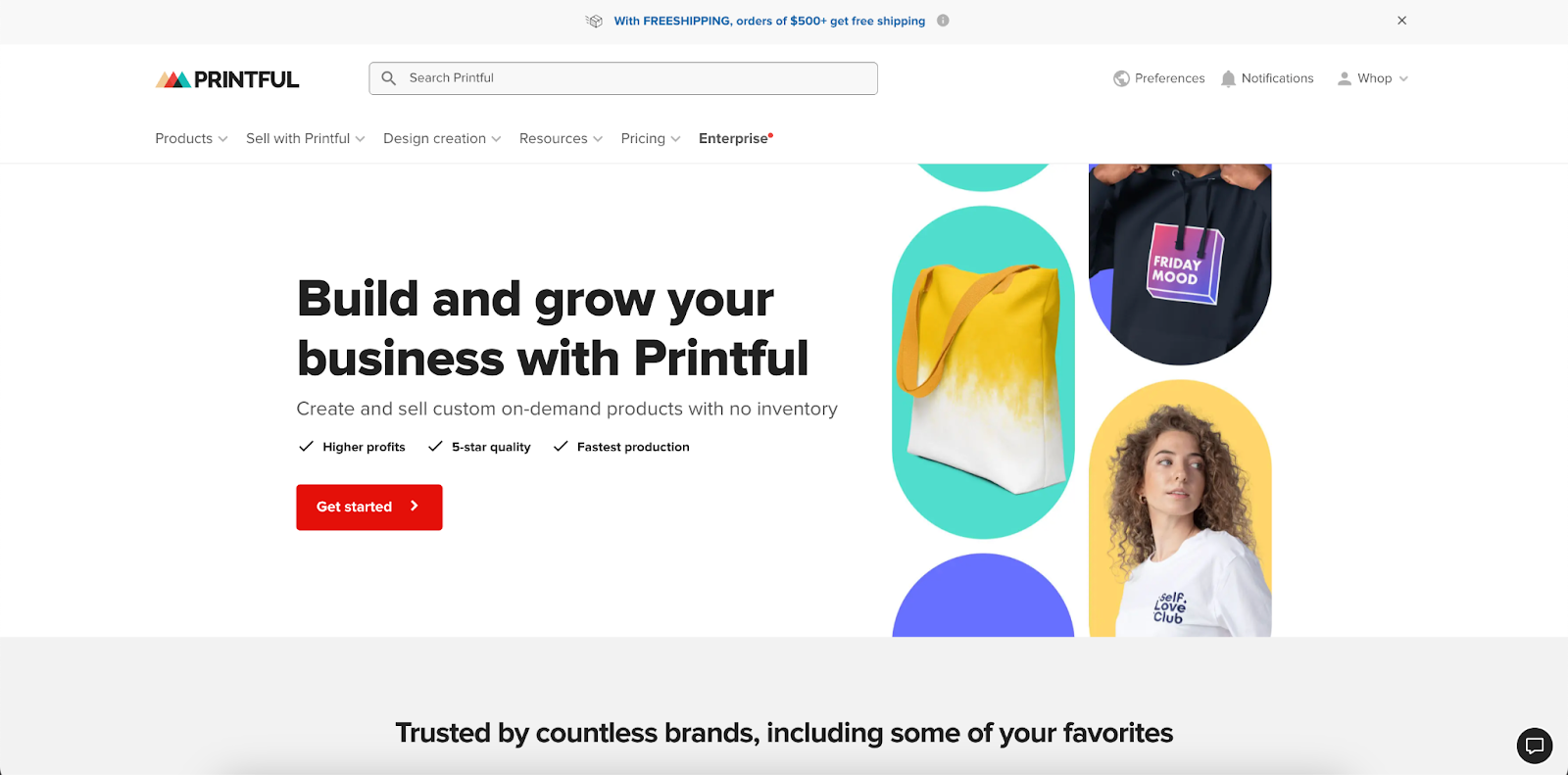
Printful sign-up is simple. We made an account in under one minute. Once you’ve done that you’ll be taken to the dashboard. Here you can access everything Printful - from the product catalog and image library to branding billing and order management. Take a look around, this is where you’ll be spending a lot of time.
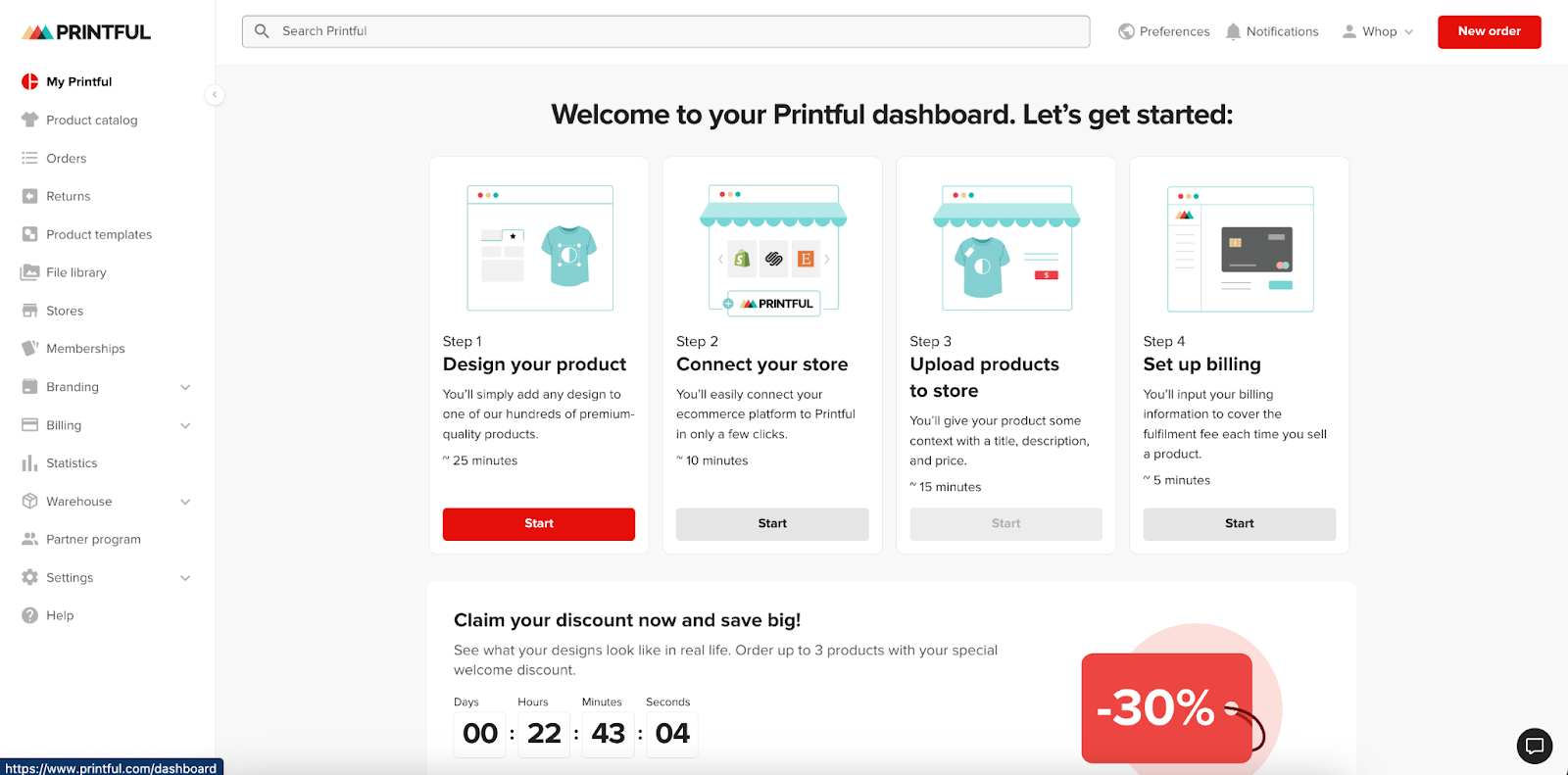
You’ll be welcomed by some tips on how to progress your store, starting with designing a product, creating a store, and setting up billing. If you’re lucky you might also get offered a start-up discount. We were offered 30% off when ordering three products.
Designing a product
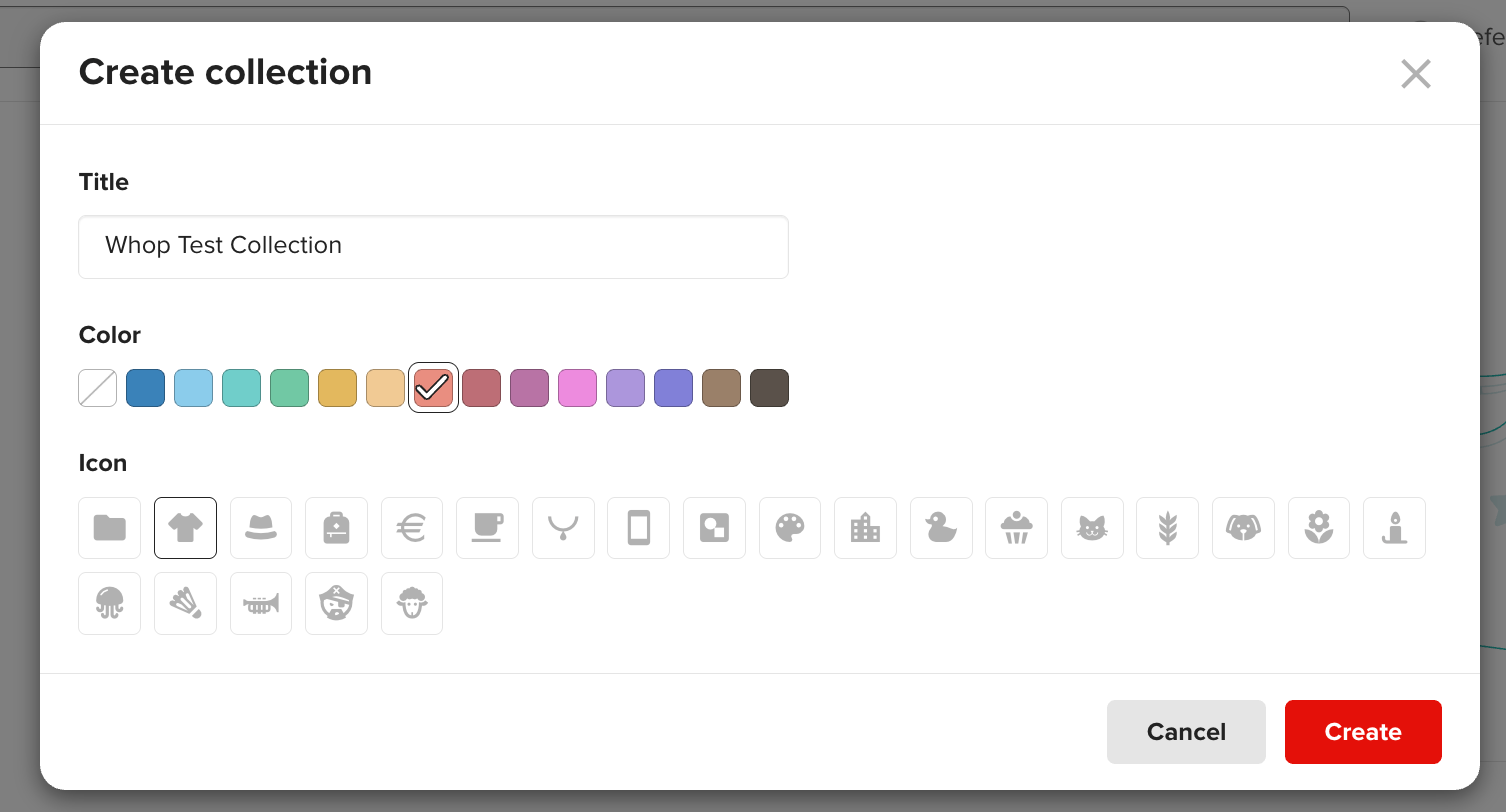
We’re going to go through the product creation process. You can start by clicking ‘start’ under step one, or on the ‘Product Catalog’ tab on the left panel. Printful will then give you the chance to create a collection or go straight to a new product. We’re going for the collection option to keep things organized.
Hit create and you’ll be taken back to the previous screen.
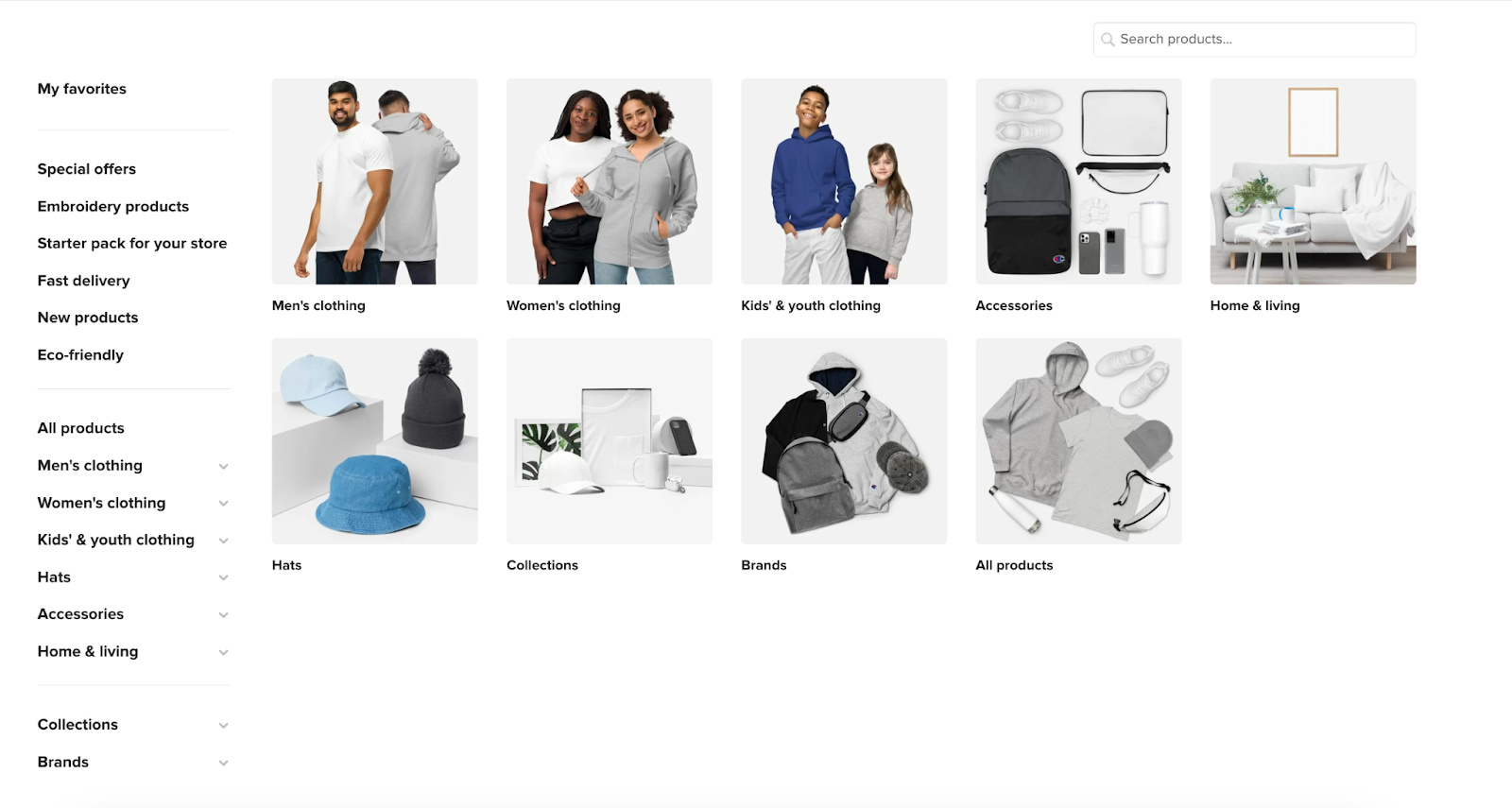
Now, it’s time to add a product so click ‘create a product’. You’ll then see Printful’s product catalog of around 200 different items. We’re going to make a sweatshirt. Once selected, you’ll get taken to the Printful Designer.
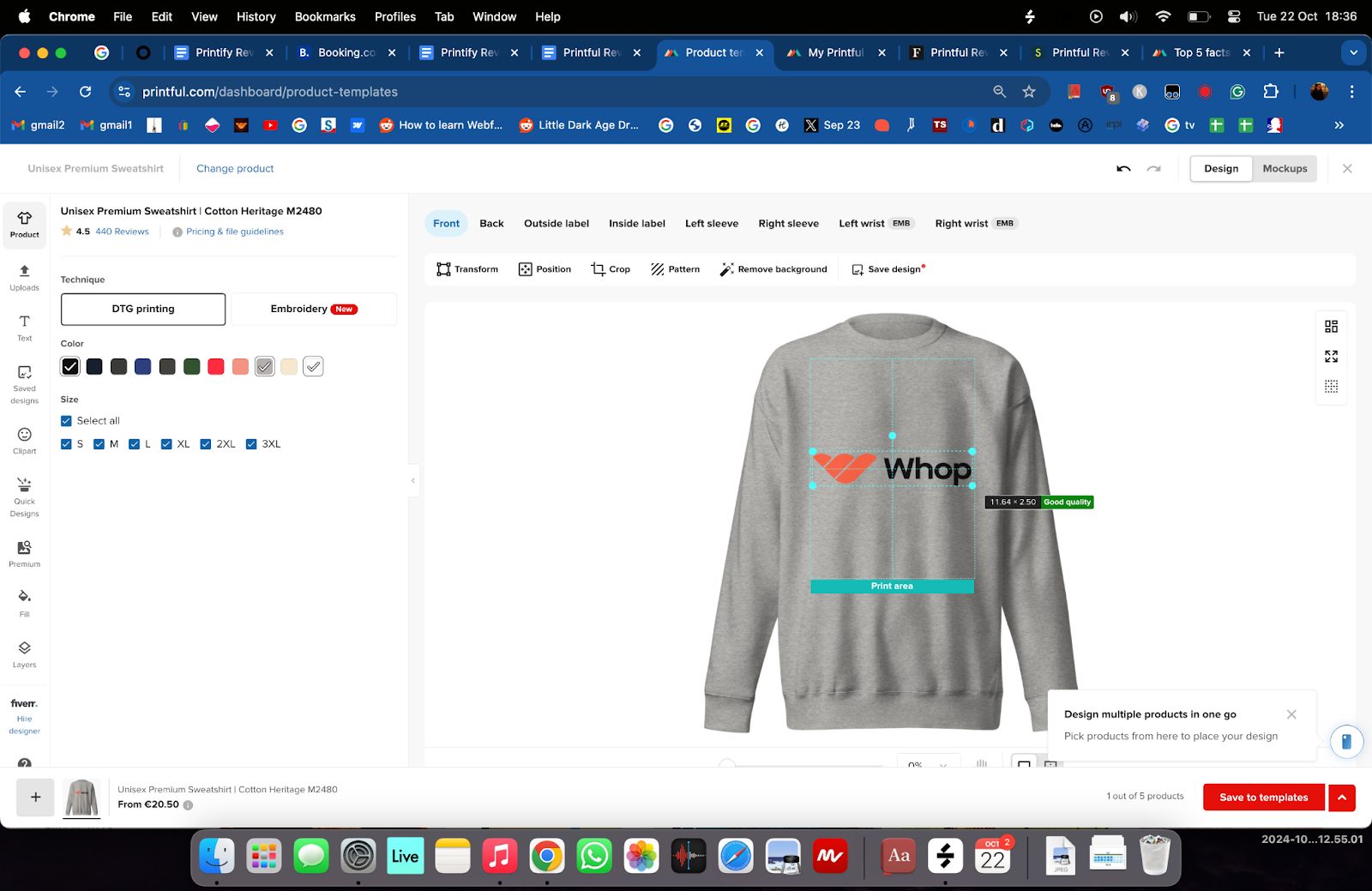
Designing is fairly simple. You can upload an image from the panel on the left, add text, pre-made graphics, or even premium images (for a small fee). You can choose from multiple product colors and apply your designs to them before saving.
We’re fans of the ‘layers’ tab, which allows you to overlay images and graphics like you can with a program like Photoshop. The auto-remove background feature is also a nice touch.
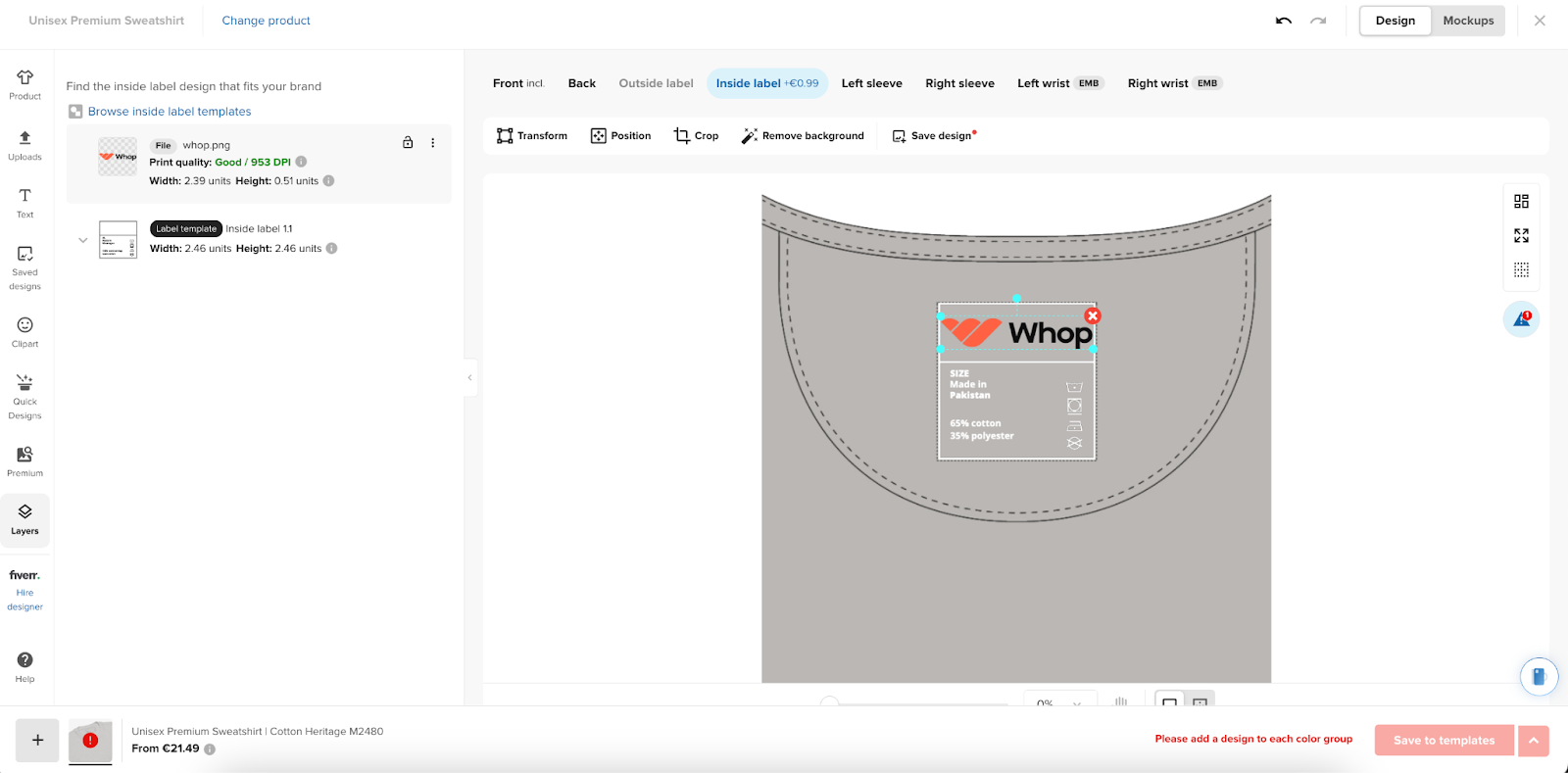
If you want to change the design area of the product, select the position at the top. Here you can even add custom neck labels with any custom image. We’ve gone for a logo, but there are no limits to what you put here.

You can also save designs for later, so you can apply them to similar products without restarting the entire design process. If you look at the bottom right, you’ll see a circle that allows you to quickly apply your design to other products. Easy.
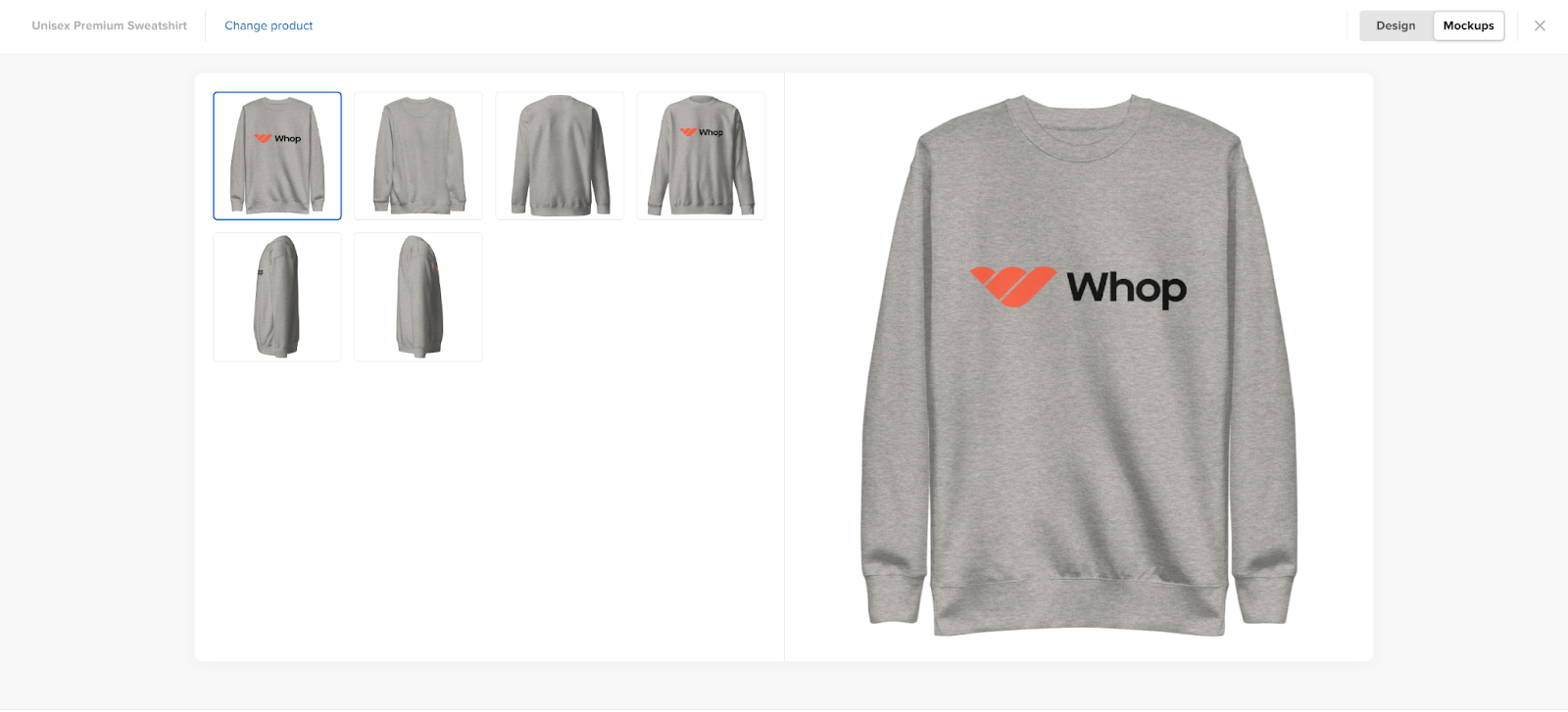
You can then click ‘mockups’ in the top right and see how your product looks from different angles. This feature is disappointing compared to Printify, as the mock-ups don’t reflect real-world use and lighting as well Even the ‘custom mock-up’ option is just an overlay of fake images or cheap-looking backdrops.
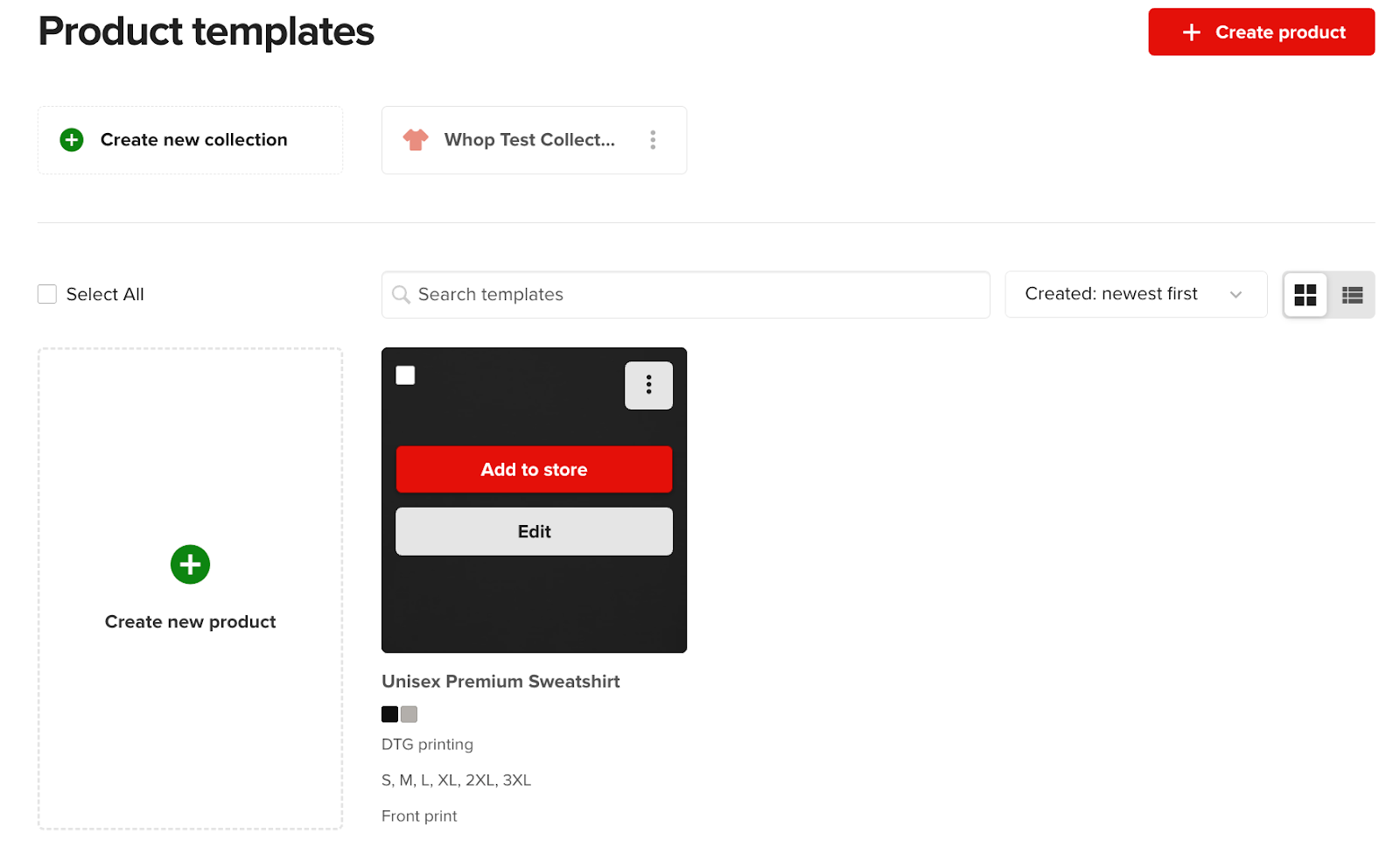
Publishing your product
Once you’re happy with your design, click ‘save template’. You’ll then be taken back to your saved products page. If you click ‘Add to store’ now you’ll be told that you don’t have a store connected. So, let’s get to that.
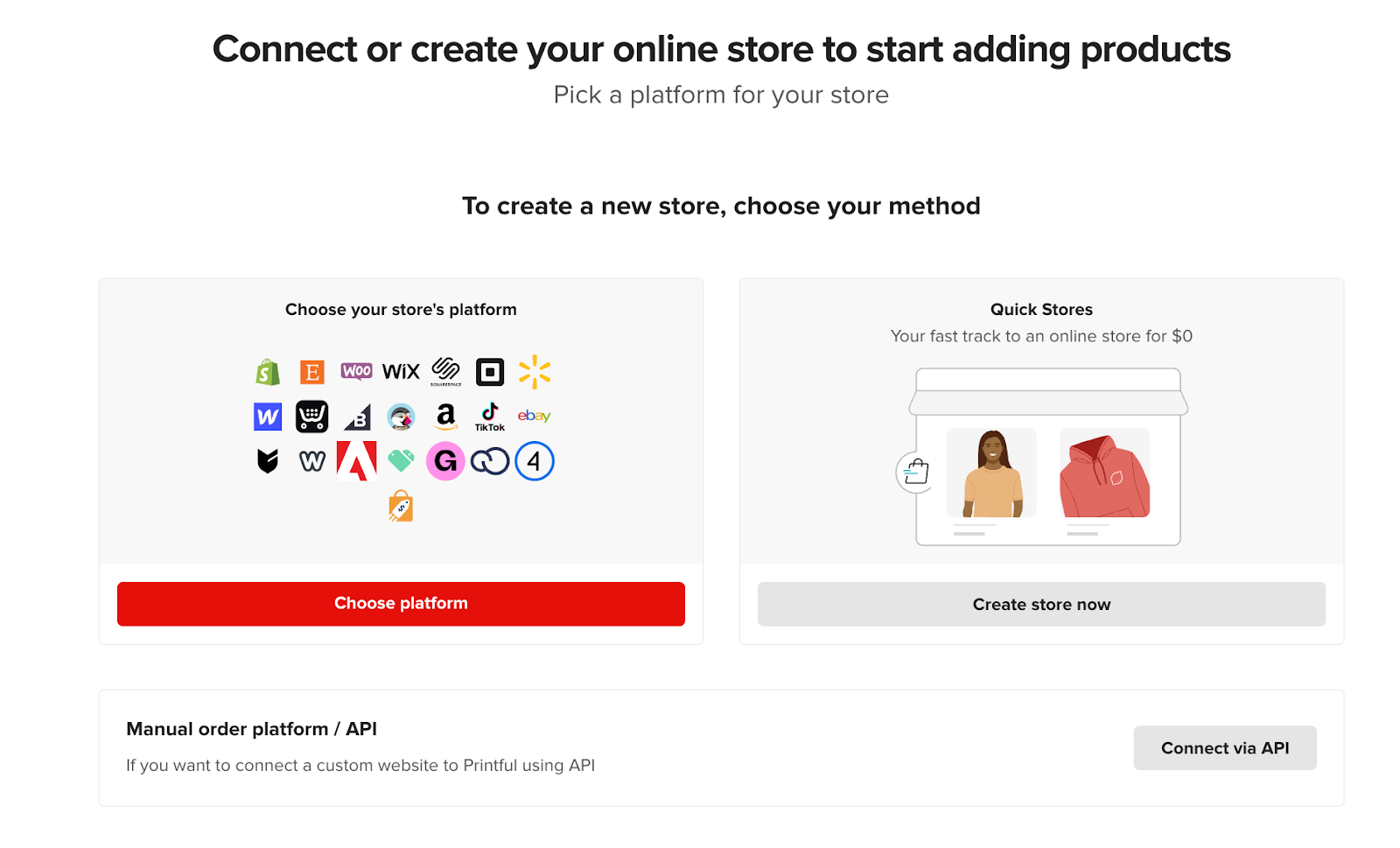
Printful gives you the option to integrate your store into external platforms such as Shopify, Etsy, Wix, TikTok, and eBay. If you have a pre-existing store on a platform then hit ‘choose platform’.
If you don’t have one, you can click ‘Create store now’ to create a Printful store (this is only available to U.S.-based users). You can also scroll down and try out their quiz which, after completion, will recommend you which stores fit your goals best.
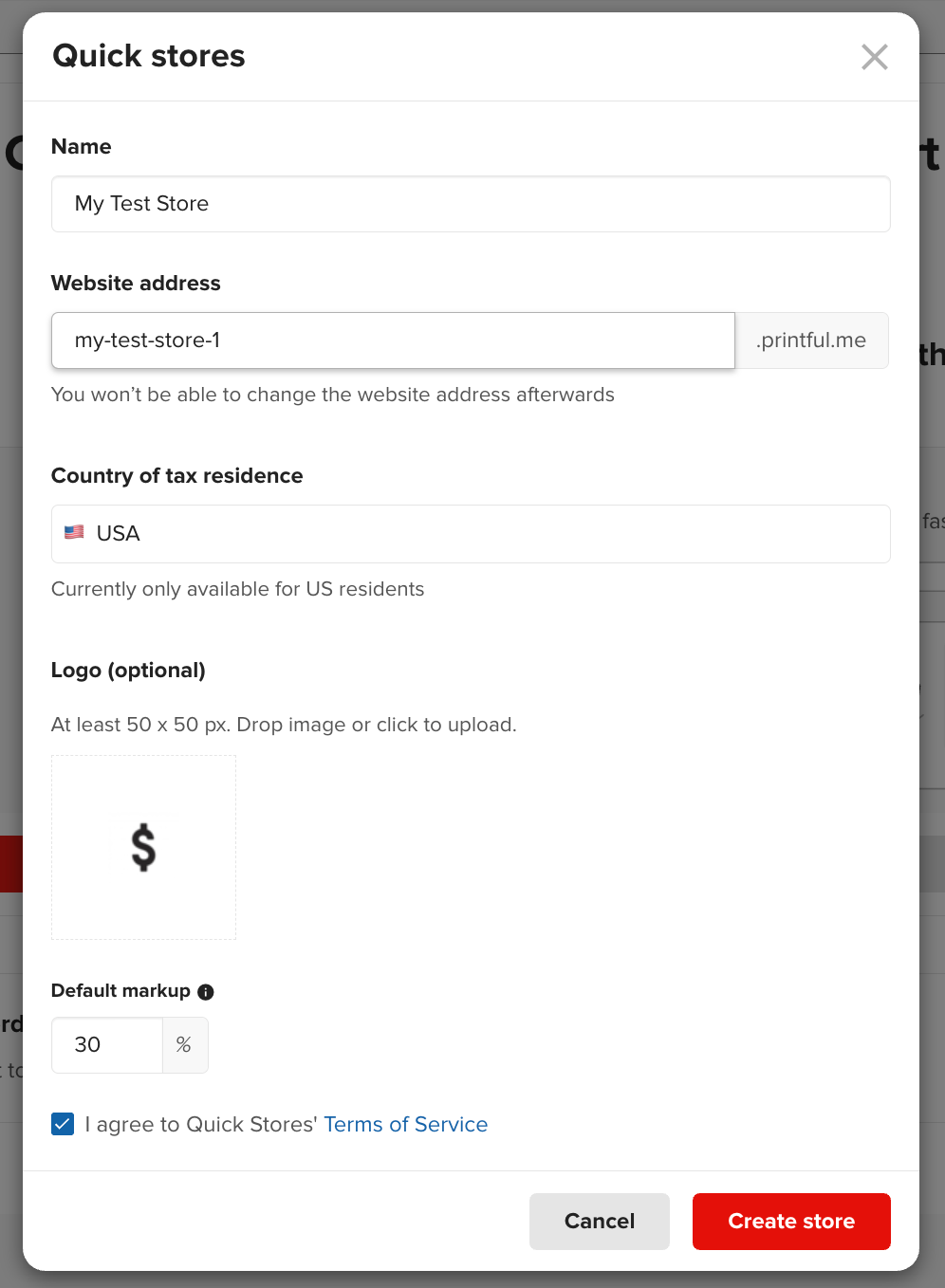
Creating a quick store is easy. Choose a name, a URL, and a logo and agree to Quick Stores’ Terms of Service. Once created you can then add your pre-created product from the ‘Product template tab’.
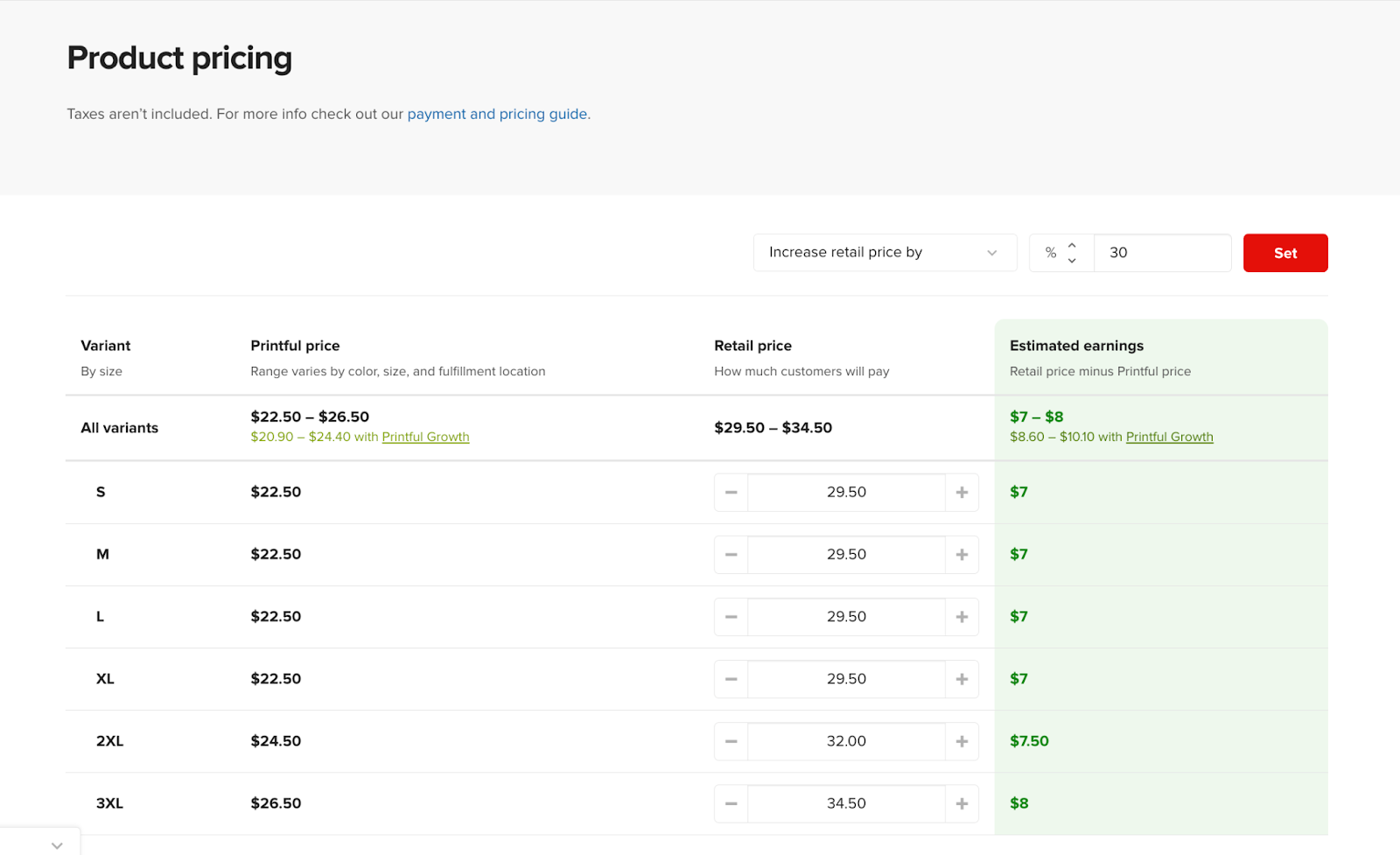
After entering the name and description of your product, you’ll get to choose your pricing. This comes with a useful ‘estimated earnings’ tool, so you can try to gauge what the optimal price is.
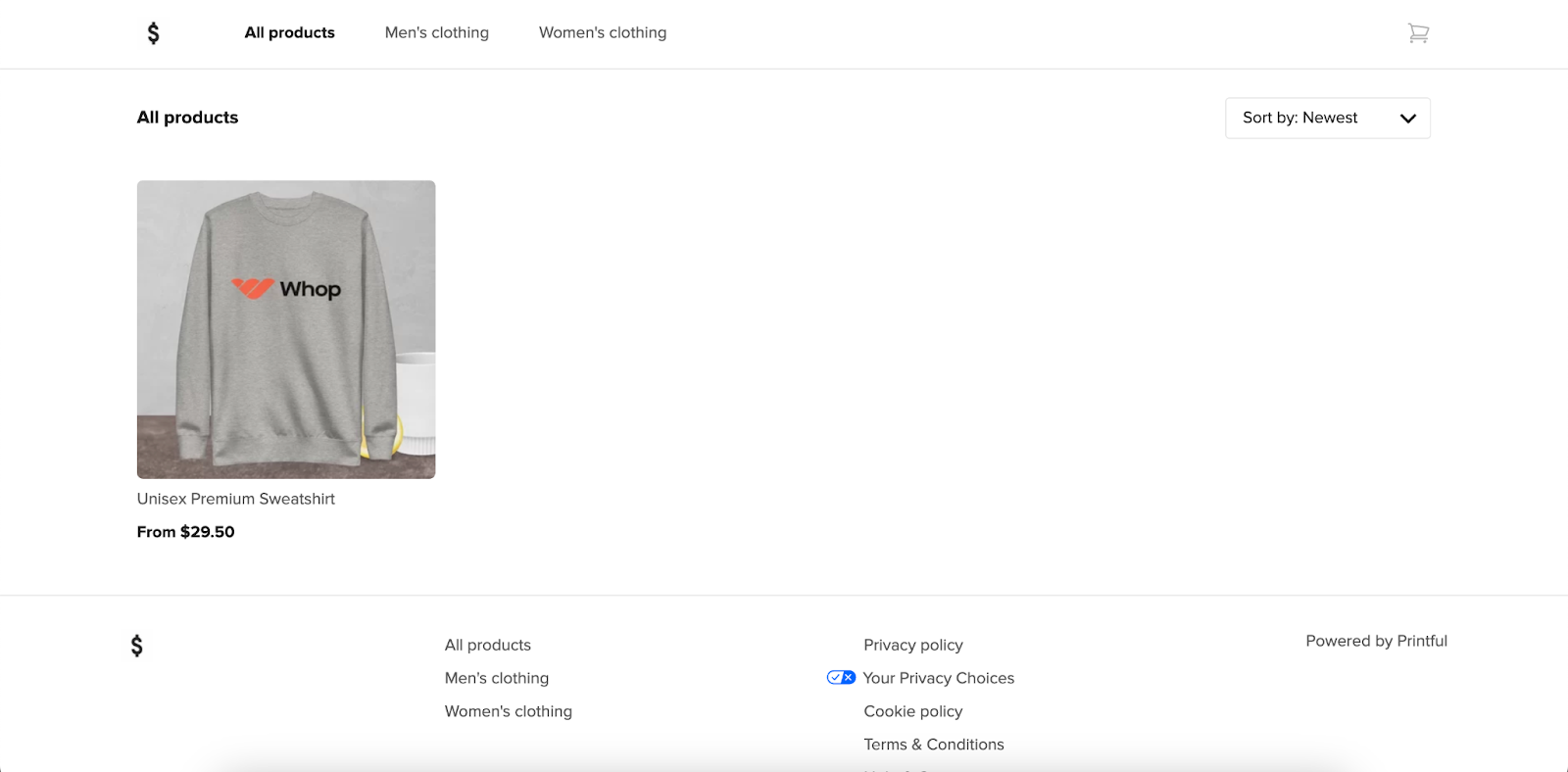
Click save and your product will now be live, in your store! It’s ready to make you money.
Fine-tuning your store
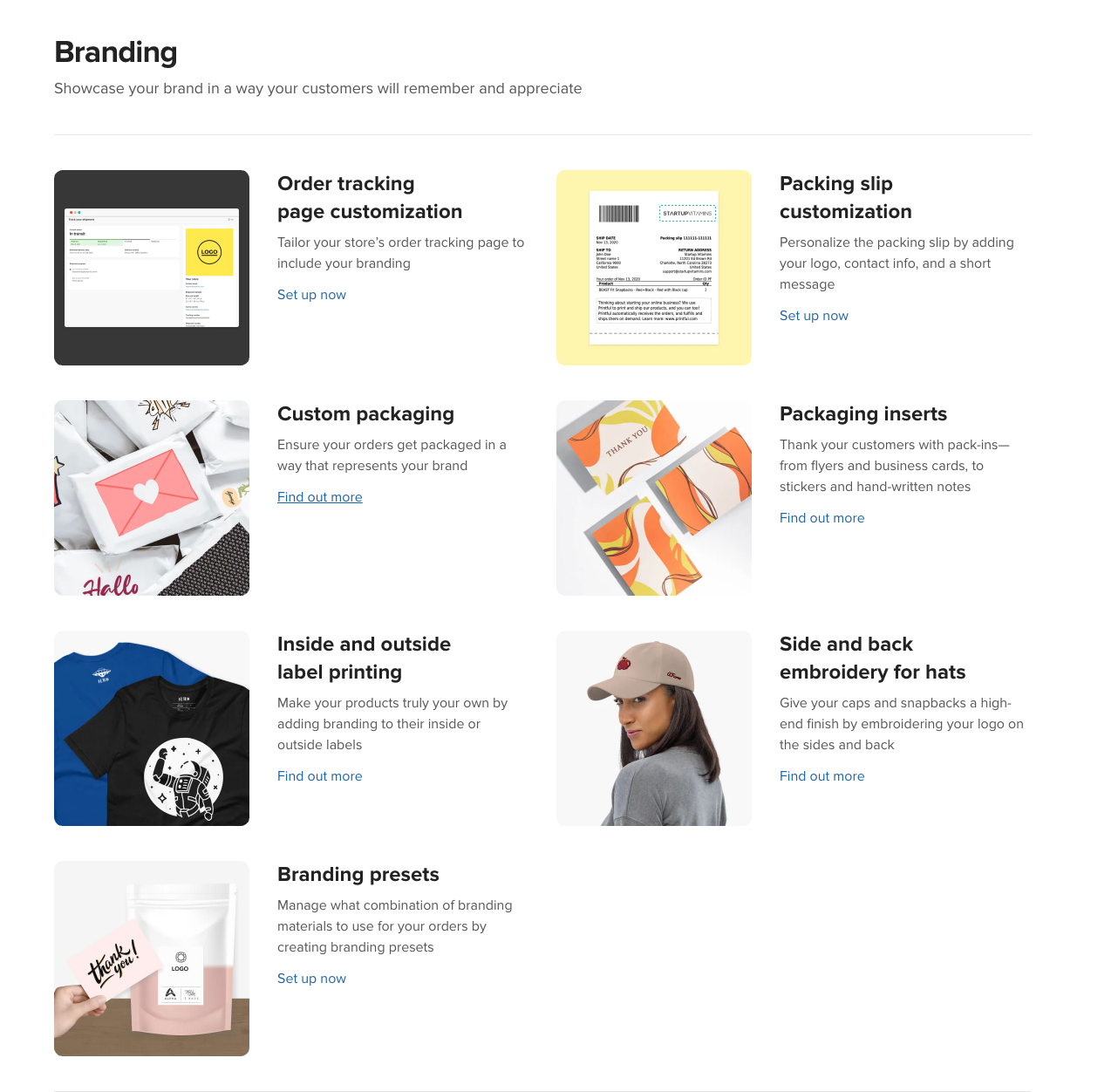
Navigate back to the Printful dashboard to start fine-tuning your store with custom branding and other set-up features. You can customize anything from billing methods and partner programs to customized branding.
We’re pleased with the level of branding you can deploy, with custom packaging, in particular, offering a more personalized shipping experience compared to Printify.
You can also consider signing up to Printful’s partner program. With that, you could earn extra income via affiliate and referral commissions.
Order management
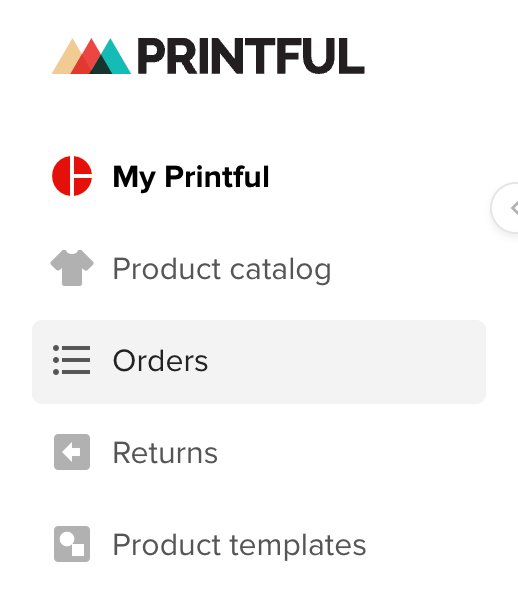
Printful’s order management can be found on the ‘Orders’ tab, on the left panel. Here you can view order status, values, and IDs, or edit active orders and access customer contact information.
There is also a ‘Returns’ tab, so you can track any items that your customers have returned. Returned items can be reshipped to another address, donated, or stocked in Printful’s warehouse for a fee.
Printful also has a ‘Warehouse’ section which gains it a plus point over Printify. The ‘Warehouse’ section allows you to cut delivery times by storing inventory (such as drop-shipped products, stickers, cards, and branded packaging) in Printful’s warehouses.
Security review
Printful comes with the expected two-factor authentication (via app or SMS) and uses built-in security features to secure the data and safety of your POD business.
However, given the lack of team management and user roles, password sharing is your only solution and of course, opens up the risk of unwanted breaches or data leaks. Note that Printify also lacks any team management.
What is Printful’s customer service like?
Printful offers a live 24/7 text chat, contact form, and help forum. There is no option to call via phone. Printful has a 4.7 rating on Trustpilot, with 79% of users giving it 5 stars. However, 10% report 1-star and complain about their difficulties with customer service especially given the lack of phone support.
What is Printful’s printing quality like?
Printful promises that they do printing quality checks before dispatching products, as part of a 3-step quality check. However, we read online reviews and found that generally there is a mixed consensus, with reports of disappointing printing.
But a site like Printful doesn’t gain over 1 million users with terrible printing, so we advise you to order a sample if you’re concerned about quality.
Printful offers direct-to-garment (DTG) and screen printing, but generally is more focused on DTG printing, especially for small orders and complex designs.
Printful also lists its printing and embroidery equipment, which may help inform your decision:
- Kornit series printers and inks for DTG apparel
- Coloreel embroidery machines for unlimited color products
- Happy and Tajima embroidery machines for hats
- MS printers and inks for all-over print products
- Mimaki inkjet printers for sublimation products
- Mimaki UV printers and inks for phone cases
- Epson series printers and inks for wall art
- SubliJET HD ink for mugs
How does payment work on Printful?
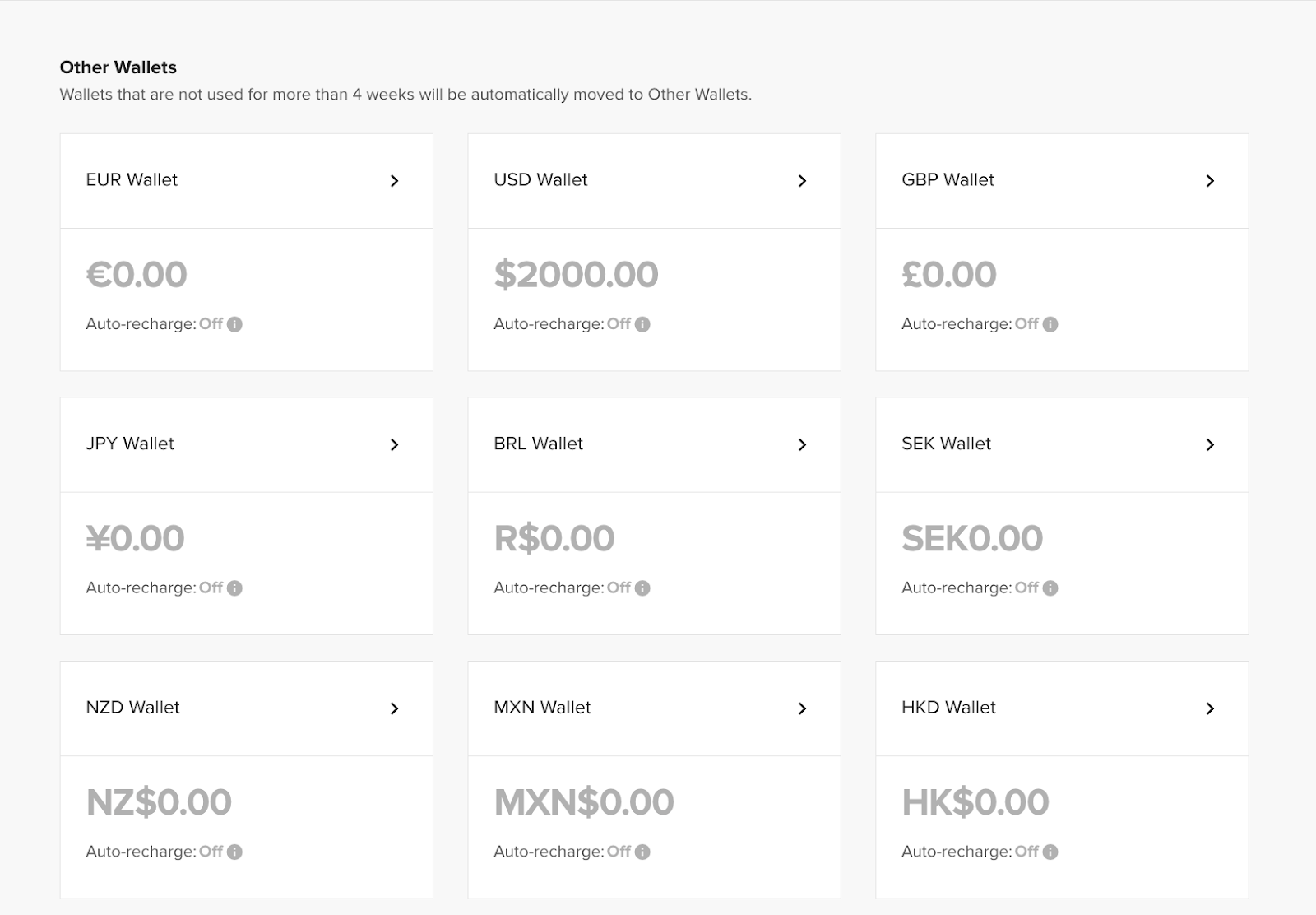
As Printful is a free-to-use service with no upfront costs, you only pay for the cost of the product production and shipping (unless you’ve selected for the customer to pay for it).
When you get an order, the customer pays. Printful then takes their cut and you take your profits.
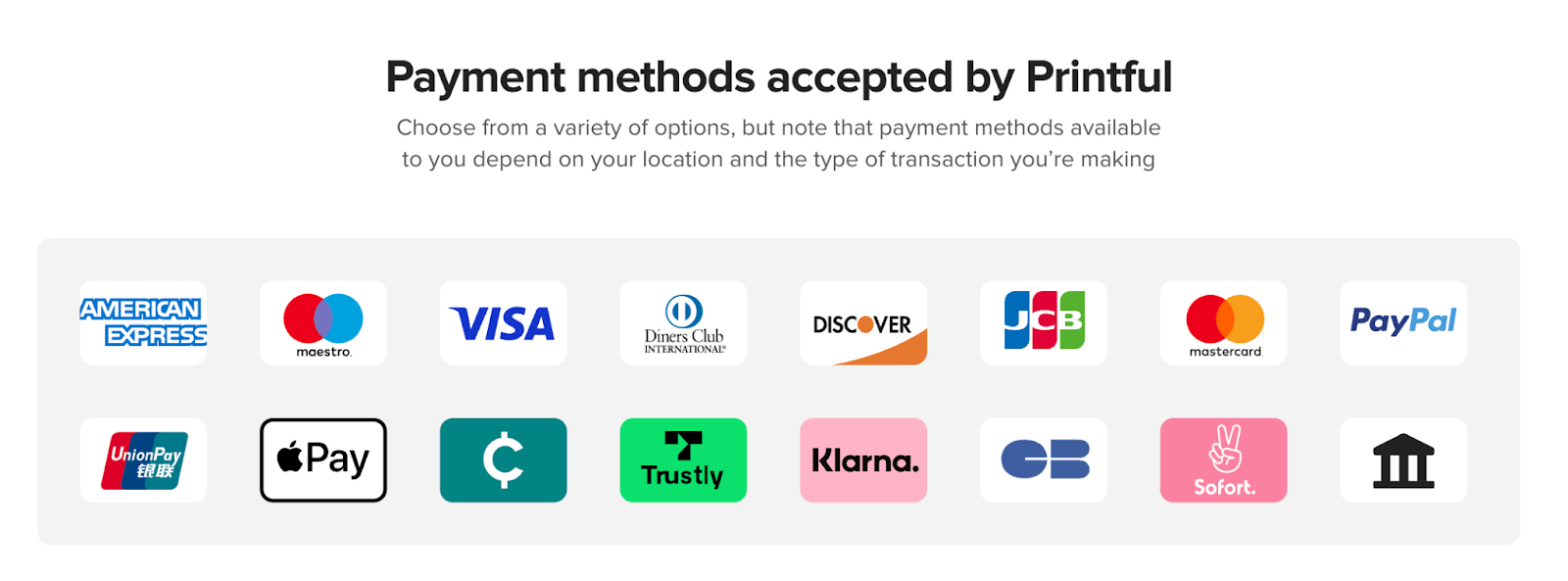
To accept transactions, you must have a payment service provider set up in your store. You can use direct bank transfers, credit cards, or online payment systems like PayPal, Klarna, or even cryptocurrency.
It’s wise to think about what your audience is likely to use. Printful currently accepts Stripe, PayPal, Braintree, and Amazon Pay.
You can also use the Printful Wallet feature to automate your payments if you’re afraid that your credit card will reach its daily limit. To do this, pre-deposit funds into your Printful Wallet and turn on auto-recharge.
Printful sustainability review
The effect of POD services on the environment is a common concern. Printful is aware of this and reports that its average carbon footprint for a product is 12.52 lbs (5.68 kg) of CO2. Around 96% of its emissions come from indirect activities, with the remaining 4% from in-house energy and fuel consumption.
Printful also uses post-consumer-recycled (PCR) plastic to package customer orders for around 70% of its orders.
Printful also has an eco-friendly range, which includes 39 products (compared to Printify’s 50).
Alternatives to Printful
Printful vs Printify
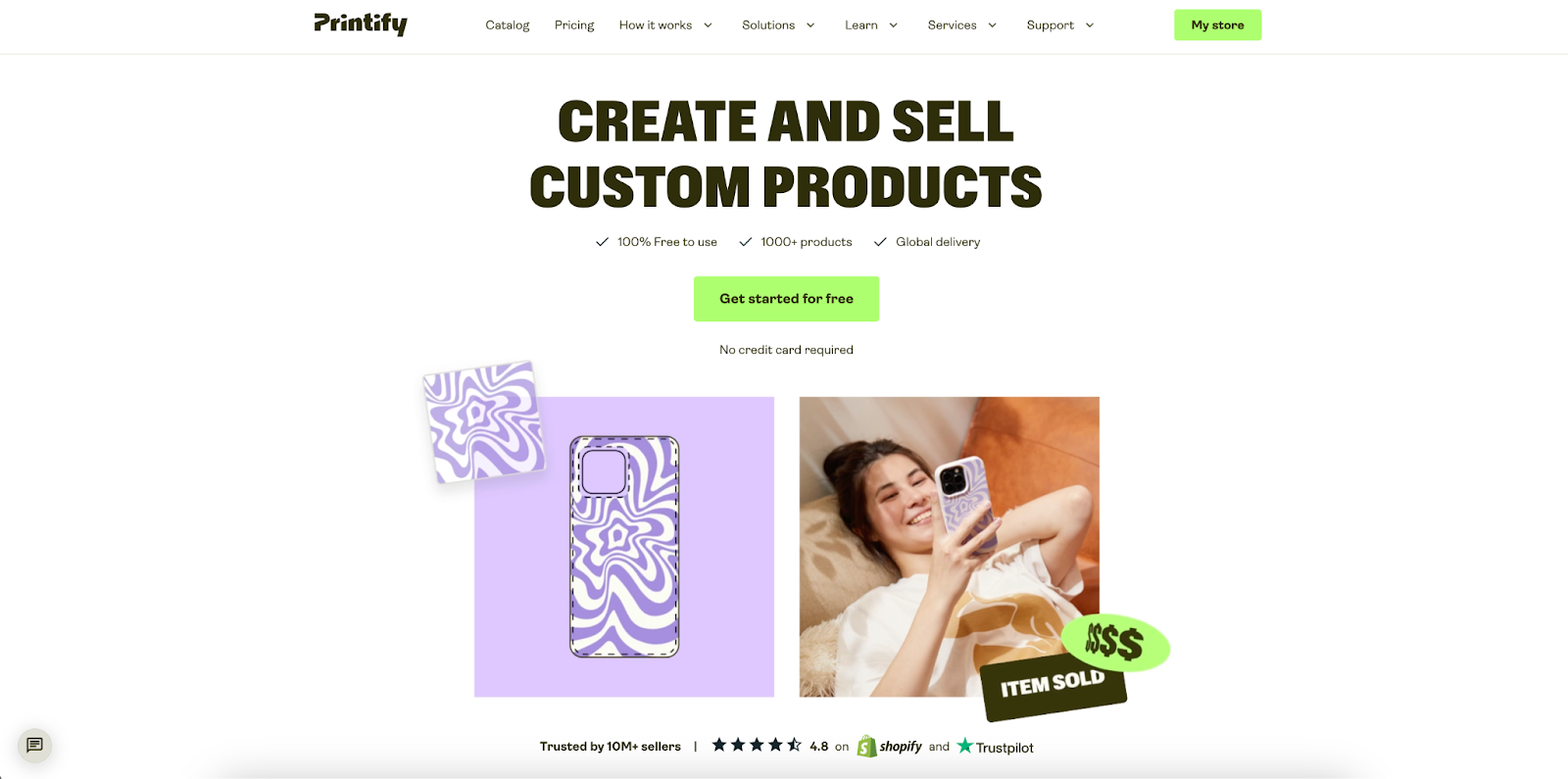
Printful and Printify are the two major rivals in the POD industry. With both offering free accounts and unlimited designs, they effectively do the same thing.
However, Printful significantly lacks in product catalog quantity with around just 200 items compared to 900 from Printify. Printify also offers higher profit margins due to low product costs and shipping typically being paid for by the customer.
Printful, however, does gain points thanks to its extensive integration options. Printify does not offer direct integration to Webflow or Adobe Commerce, which instead relies on API use.
Printful also has features such as the Warehouse pre-stock feature and custom packaging which may be a defining difference for some business owners.
Printful vs Redbubble
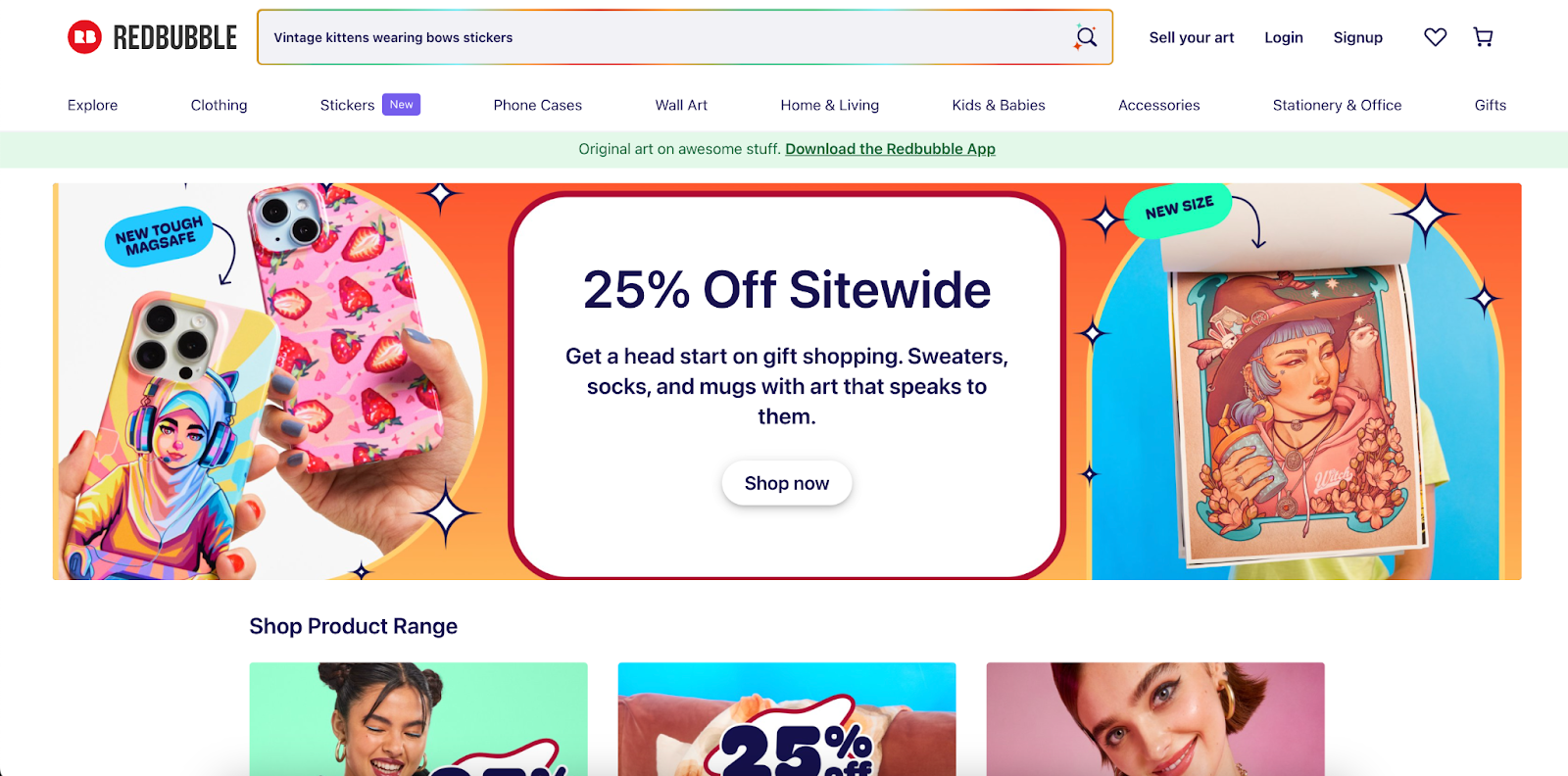
Redbubble significantly differs from Printful as you can only sell Redbubble products on Redbubble’s site. There is no option to integrate your store on external marketplaces or websites.
Redbubble also only sells around 70 products, which is less than 50% of Printful 200. However, Redbubble has a large pre-existing customer base which means you may be able to gain quick sales.
Printful vs Zazzle
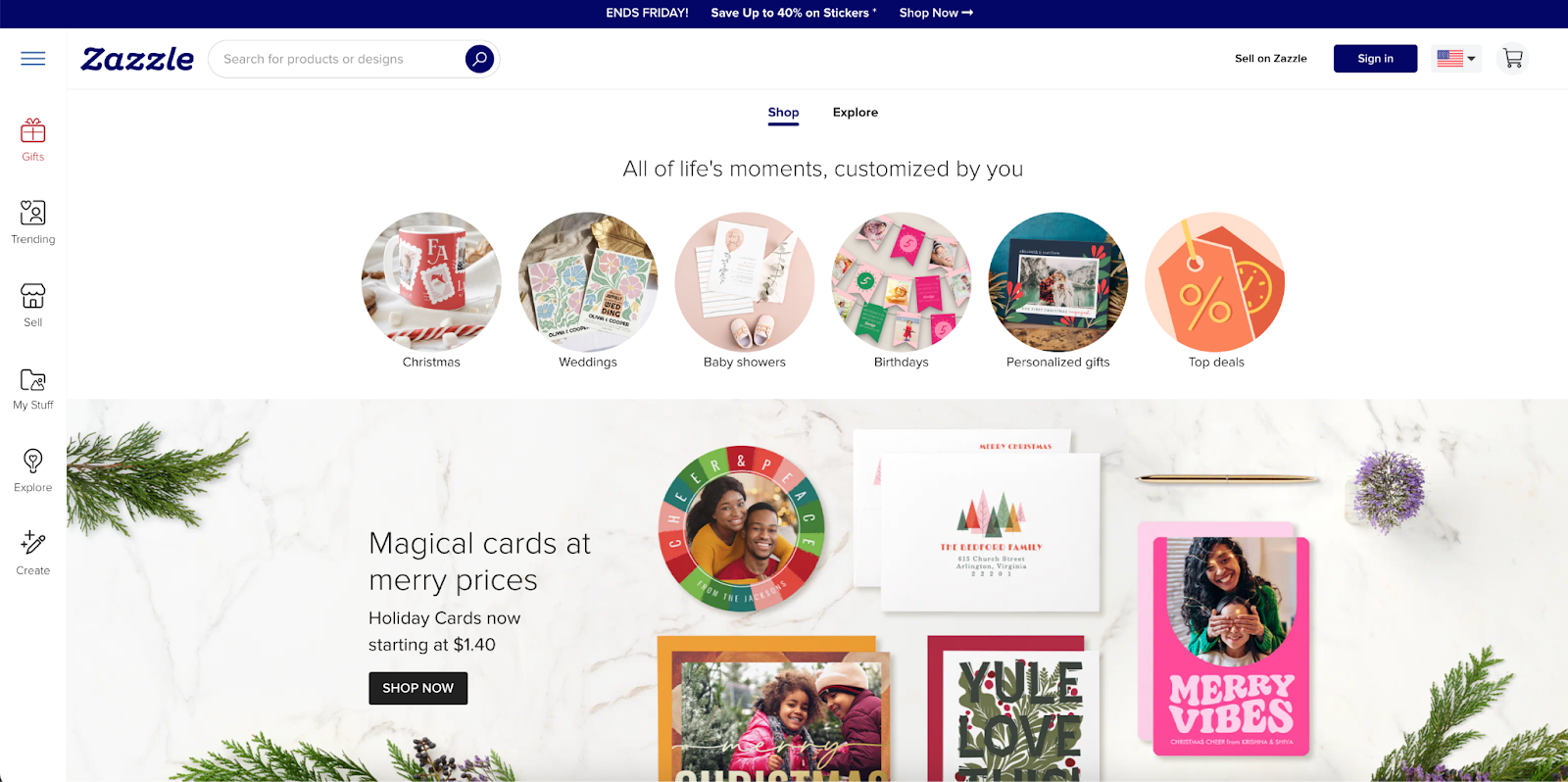
Zazzle uses its own pre-existing marketplace, so you don’t have to worry about marketing the product externally. However, like Redbubble, that means you can’t use integration on external sites or platforms.
Zazzle’s user experience is also commonly criticized due to its limited design function and unreliable product shipping, quality, and pricing. Like Printful, Zazzle also allows you to earn commission via its affiliate program.
| Printful | Printify | Redbubble | Zazzle | |
|---|---|---|---|---|
| Cost | Free | Free | Free | Free |
| Product range | 230+ | 900+ | 100+ | 70+ |
| Design limit | Unlimited | Unlimited | Unlimited | 30 per day |
| Create a store | Yes | Yes | No | No |
| External integration | Yes | Yes | No | No |
| Custom packaging | Yes | No | No | No |
| Customer support | 24/7 chat | 24/7 chat | Forum | Chat and phone |
Is Printful the right choice for your POD business?
In our opinion Printful and Printify should be at the top of your list for choosing a POD service. When deciding between the two, you’ll need to weigh up your priorities.
If you want high-profit margins, great mock-ups, slick integration, and designs then go for Printify.
If you want quicker shipping times, custom packaging, crypto payments, and webflow integration, then go with Printful.
If you have sustainability concerns, we recommend browsing Printful’s eco-friendly catalog to determine if their range is wide enough for your business. We also recommend ordering some samples if you’re concerned about Printful’s printing quality.
Grow your ecommerce business with Whop
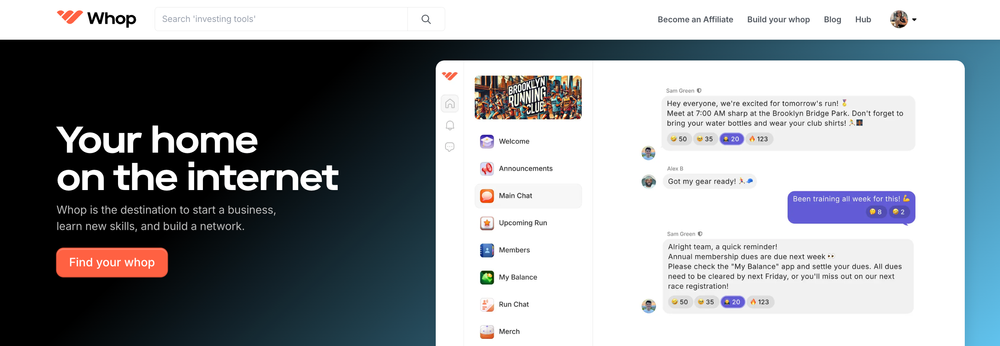
Choosing the right print-on-demand service is just the start of your ecommerce journey. After settling on either Printful or Printify, you should explore possibilities to expand your community and reach. Whop’s marketplace is packed with resources and entrepreneurs who can guide you on your journey.
With the ability to sell on Whop, it’s also an ideal place to nurture a community and provide support to your customers. Join Whop to make your print-on-demand service a success.
